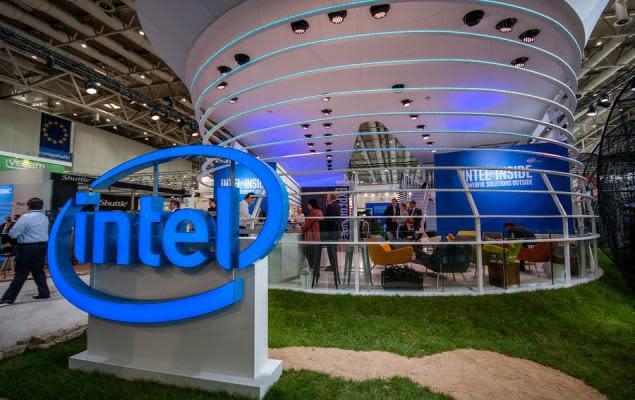At CES 2021, Intel INTC unveiled four new processor classes – 11th generation Intel Core vPro processors, 10 nanometer (nm) N-series Intel Pentium Silver and Intel Celeron processors, along with 11th-generation Intel Core H series mobile processors – to boost performance PCs in business, games, education and mobile spectra.
The chipmaker also previewed products that are expected to make their debut in 2021. The products presented by the company included 11th generation Intel Core S-series desktop processors and next generation processors, dubbed Rocket Lake-S and Alder Lake , respectively.
Alder Lake processors are built on an enhanced version of their 10 nm SuperFin technology and are expected to be unveiled in the second half of 2021, Intel added.
Intel Corporation pricing and consensus

Intel Corporation price consensus chart | Intel Corporation quote
A look at the remarkable features
Intel’s 11th generation Intel Core vPro processors aim to improve the performance of laptops for commercial use. These processors are based on Intel 10 nm SuperFin technology and feature Intel Iris Xe graphics.
Processors are also integrated with Intel Wi-Fi 6 / 6E (Gig +), which can offer upload / download speeds six and three times faster in the office and at home, respectively, compared to the Wi-Fi 5 standard, observed the tech giant.
According to Intel, 11th generation Intel Core vPro processors offer up to 23% relatively faster productivity when working with certain applications such as MicrosoftMSFT Office 365. It also offers 2.3 times the speed when compared to the previous generation of processors (10th generation Intel Core vPro i7-10610U processor) for creating and editing videos.
This processor family in combination with the Intel Core vPro platform features Intel Hardware Shield, which offers extensive hardware security. Intel Hardware Shield also has a silicon-enabled artificial intelligence (AI) threat detection technique to prevent encryption and ransomware attacks.
Intel’s Pentium Silver and Intel Celeron N series chips are also based on the company’s 10nm technology. According to company estimates, this class of processors can provide up to 35% and 78% of improved application performance and generation performance compared to generation.
These processors aim to improve PC performance to support online learning, triggered by the coronavirus crisis.
To enhance the gaming experience on 16mm laptops, Intel launched 11th generation Intel Core H series notebook processors. This class of mobile game processors is based on the new PCIE Gen 4 architecture and aims to enhance ultraportable games.
The emergence of cutting-edge cloud computing, the demand for thinner laptops and fast processing should bode well for the newly introduced chips. In addition, coronavirus-led work at home, home stay and online classes have increased the demand for laptops and notebooks.
According to a Specialized Market Research report, the global laptop market is expected to witness a 0.5% CAGR between 2021 and 2026. The global laptop market in 2020 reached almost $ 103 billion, the report added.
Given the attractive prospects, Intel’s new offerings loaded with robust features are well positioned to achieve solid traction in the market. This, in turn, favors revenue growth in the coming quarters.
Headwinds persist
Intel is witnessing growing competition in the server, storage and networking markets for companies such as Advanced micro devices AMD and NVIDIA NVDA. In addition, production delays are deeply worrying. In July 2020, the company announced the delay in the production of chips based on the 7 nm process, as it detected a major defect mode in the 7 nm process, which caused degradation in yield.
The chip maker now expects initial production shipments of the first Intel-based 7 nm client CPU in late 2022 or early 2023. In addition, initial production shipments of the first internal 7 nm data center CPU design from Intel are scheduled for the first half of 2023.
Intel’s increasing debt levels are an additional concern. As of September 26, 2020, the company’s total debt was $ 36.56 billion, while cash and cash equivalents, short-term investments and balance of fixed income commercial assets were $ 18.25 billion.
The chip maker also received a letter from Third Point LLC encouraging management to examine strategic alternatives to increase performance.
All of this was reflected in the company’s stock price. Last year, Intel witnessed a 13.5% decline in its share price against the industry’s 37.6% recovery.
Intel currently carries a Zacks Rank # 4 (Sell).
You can see the complete list of current Zacks # 1 Rank (Strong Buy) stocks here.
Looking for stocks with an upside advantage?
Zacks has just released a special report on growing legal marijuana investment opportunities.
Inflamed by referendums and legislation, this industry is expected to move from an already robust $ 17.7 billion in 2019 to an astonishing $ 73.6 billion in 2027. Early investors can make a killing, but you need to be ready to act and know exactly where to look.
See the stocks we are aiming for >>
Want the latest recommendations from Zacks Investment Research? Today, you can download 7 best stocks for the next 30 days. Click to get this free report
Microsoft Corporation (MSFT): Free inventory analysis report
NVIDIA Corporation (NVDA): Free Stock Analysis Report
Intel Corporation (INTC): Free Stock Analysis Report
Advanced Micro Devices, Inc. (AMD): Free Stock Analysis Report
To read this article on Zacks.com click here.
Zacks Investment Research
